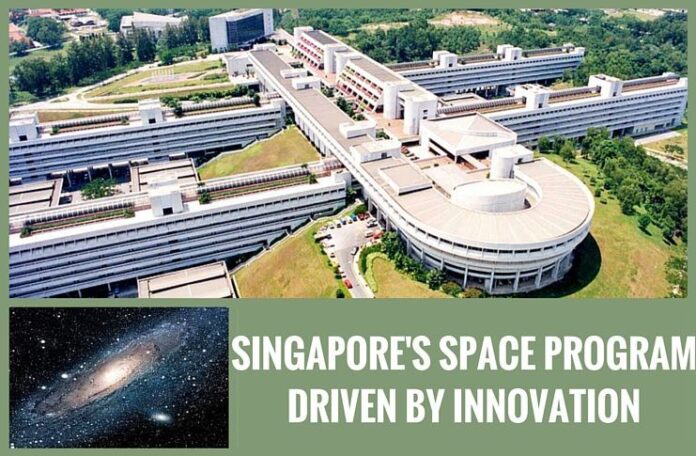
[dropcap color=”#008040″ boxed=”yes” boxed_radius=”8px” class=”” id=””]S[/dropcap]ingapore’s entry into space research is only about a decade old, and its first indigenous scientific satellite (X-Sat) was deployed in space (by an Indian rocket PSLV) only in 2011. But its scientists are already making a mark with their bold ideas and focussing on high performance with small satellites.
A ‘green’ satellite that will not become space debris at the end of its useful life and a propulsion engine that has the potential to send a nano satellite to the Moon are among several innovative technologies being developed or tested by Singapore’s satellite builders led by Nanyang Technological University (NTU), the birthplace of the republic’s space activities.
“Being a small country, development of rockets or building launch facilities is not our priority,” Low Kay Soon, director of NTU’s Satellite Research Centre, told IANS.
“Our aim is to strengthen Singapore’s reputation as a country for credible satellite technology by working on innovative ideas and advanced concepts,” he said.
An associate professor at the university, Low was not exaggerating.
NTU’s seventh satellite VELOX-III, weighing 2 kg, being readied for launch this year by Japan Aerospace Exploration Agency, will test a micro-plasma propulsion system that NTU faculty and students developed after four years of research.
[dropcap color=”#008040″ boxed=”yes” boxed_radius=”8px” class=”” id=””]S[/dropcap]mall thrusts generated by the pulsed plasma will help overcome the atmospheric drag enabling the satellite (launched into a low 400 km orbit) to continue flying in space twice as long as it would without the thruster, Low said.
“The micro-thruster can also be used to ‘de-orbit’ the spacecraft after its operating life, preventing it from remaining in orbit as a space debris — a concept that will help to promote development of ‘green’ satellites.”
NTU’s two satellites — VELOX-II and VELOX-CI — launched recently by India’s PSLV, were also meant to experiment a few innovative ideas.
A data relay terminal on board VELOX-II will enable it to relay data on command or beam back images any time or from wherever it is in space.
The communication-on-demand technology “is the first of its kind for low-orbit satellites”, Low said.
According to Low, NTU has in the last 10 years demonstrated the capability to design and develop different classes of satellites weighing from less than 1 kg to 150 kg with 80 percent of hardware made in-house.
“Our next plan is to combine both remote sensing and telecommunication fields to build an advanced satellite for real-time maritime security and for monitoring haze, a recurrent phenomenon in this region.”
Also propping up Singapore’s space programme is the National University of Singapore (NUS) — the country’s oldest institution of learning.
It made a foray into space with its first two satellites — Galassia and Kent Ridge-1 — that also flew on board the PSLV last December.
“Both carried payloads to test innovative concepts,” Goh Cher Hiang, professor and project director of the NUS Satellite Program, told IANS.
[dropcap color=”#008040″ boxed=”yes” boxed_radius=”8px” class=”” id=””]G[/dropcap]alassia, weighing 2 kg, and built by final-year engineering students, will perform a quantum physics experiment that Alexander Ling of NUS says “is the first step towards a secure global quantum communication network using satellites”.
The follow-on Galassia, slated for launch around 2020, has a bolder role.
“The propulsion system with enhanced capability that the satellite will test might eventually enable an interplanetary mission such as flying a nano-satellite to explore the Moon,” said Goh.
He did not elaborate but said “cold-gas propulsion” — that typically uses an inert gas as the reaction mass — is one option being considered for Galassia-2.
“The December 16, 2015, launch of Singapore’s six satellites from India was an important and exciting milestone for us,” Beh Kian Teik, executive director of the Office for Space Technology and Industry (OSTIn), responsible for the development of Singapore’s space industry, told IANS in an email.
“It validates our indigenous capabilities in satellite engineering.”
He said Singapore was focussing on building up its research capabilities in small satellites, because it sees tremendous growth potential for these.
Just as the size of a computer reduced drastically over the years, Beh expects the satellites will get smaller and cheaper while performing as well as their larger cousins of today.
Singapore hopes that when that day arrives, it will be a leader in satellite industry.
Notes:
1. IANS
- Pentagon cancels aid to Pakistan over record on militants - September 2, 2018
- The curious case of Tamil Nadu’s opposition to NEET - September 4, 2017
- If 2.6 Billion People Go To War: India vs. China - July 22, 2017







